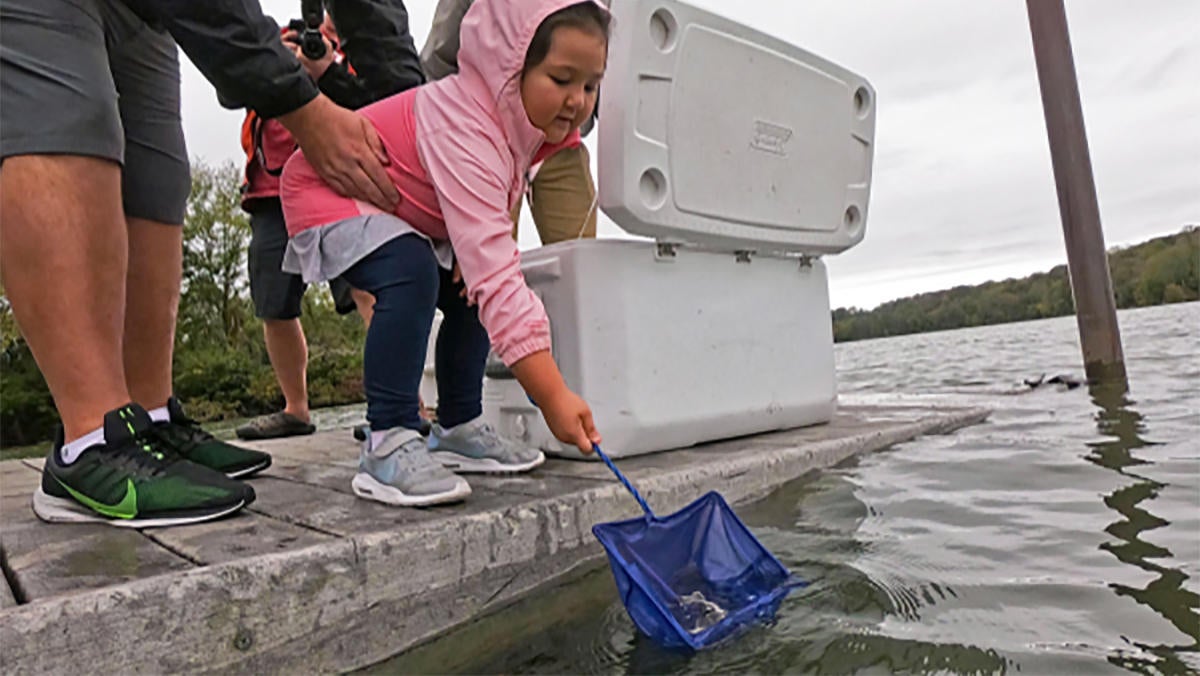Age-old wisdom claims it takes a village to raise a child. As it turns out, the same could be said of the effort to rescue a river giant.
Despite being one of the largest fish in the Tennessee River and boasting lifespans that can stretch past 150 years, the lake sturgeon was pushed to the brink of disappearing from the Southeast during much of the 20th century. Due to a combination of human activities, including overfishing, pollution and damming, this riverine titan had vanished from the Tennessee and Cumberland Rivers and their tributaries by the 1970s.
By 1998, changes to clean water legislation and river management practices had improved the Tennessee River as a potential habitat for sturgeon. That year, the Tennessee Aquarium helped to found the Lake Sturgeon Working Group. This umbrella group represented a host of government and non-profit organizations joining forces to restore the Lake Sturgeon to the historical waters from which it had been ousted.
On the shores of Watts Bar Lake in Kingston, Tennessee, on Oct. 12, the Aquarium hosted the most recent release into the wild of juvenile sturgeon raised in human care.
Bundled up against suitably bracing weather under overcast autumn skies, about 100 children and adults, including a handful of recreational anglers, gathered with the Aquarium’s team of freshwater scientists. On the shores of the wind-rippled reservoir, they carefully deposited the six-inch-long sturgeon into the water, one netful at a time. In all, about 350 juvenile fish were released.
“Releasing sturgeon back into the river is the perfect example of how the work we do at the Aquarium has a real conservation benefit for animals in the wild,” says Dr. Anna George, the Tennessee Aquarium’s Vice President of Conservation Science and Education, adding that the significance of these reintroduction events has yet to fade.
“Actually, over the years, I think they’ve become even more meaningful to me,” she says.
Based on the most recent available numbers for that restoration effort, the Aquarium and its partners have now raised and released more than a quarter of a million juvenile Lake Sturgeon to the Tennessee and other Southeastern waterways in its historical range.
As of the Oct. 12 release, the Aquarium has reintroduced 1,508 of these freshwater giants-in-waiting into the Tennessee River system in 2019 alone. Since releases began in 2000, about 29,600 sturgeon – more than one in nine of the 252,315 reintroduced by the entire Working Group – have been cared for and returned to the wild by the Tennessee Aquarium Conservation Institute.
Passing the milestone of 250,000 released fish highlights the importance of scientific stamina and collaboration when it comes to approaching large-scale rescue efforts for imperiled species, says Dr. Bernie Kuhajda, the Aquarium’s Science Programs Manager.
“There’s no way we could have reached these numbers without all of our partners,” Kuhajda says. “This partnership that we’ve developed is like the car that reaches a quarter of a million miles – it was well-built and long-lasting. Those quarter of a million fish reflect the great partnerships we’ve got and the hard work that has gone into this project these last 20 years.”
Partners in the Southeastern Lake Sturgeon Working Group include:
·U.S. Fish and Wildlife Service
·Tennessee Wildlife Resources Agency
·Tennessee Valley Authority
·U.S. Geological Survey
·The Tennessee Aquarium
·Tennessee Technological University
·University of Tennessee at Knoxville
·Conservation Fisheries Inc.
·Kentucky Department of Fish & Wildlife Resources
·Georgia Department of Natural Resources
·North Carolina Wildlife Resources Commission
·The Tennessee Clean Water Network
·Wisconsin Department of Natural Resources
·World Wildlife Fund.
That the Working Group has now released a quarter of a million fish is significant, numerically, but the scientists involved in the reintroduction effort say they are now focused the next big biological milestones in the 21-year-old project.
As with many long-lived species, Lake Sturgeon are late to reach sexual maturity – 15 years for males and 20-33 years for females. That means the first sturgeon raised in human care and reintroduced will only just have begun to reach the age at which they could begin to lay and fertilize eggs that will produce a new generation of wild sturgeon.
The prospect of seeing the first sign of reproduction – suggesting the Tennessee River may once again be host to a self-sustaining population of Lake Sturgeon – is an even more enticing carrot than a number by itself, Kuhajda says.
“My next big milestones are, ‘Will we find females with eggs ready to spawn?’ and, after that, ‘Will we find fertilized eggs and then babies?'” he says. “Those moments will be like the completion of this big, wonderful, long-term picture that the folks back in the late ’90s envisioned when they established the working group.
“It’s kind of frustrating and cool all at the same time to wait 20 years to find out whether the work you’ve done has been successful. That speaks to the commitment of everyone involved in sticking with this project long enough to see if we can successfully restore this species to its native waters.”












